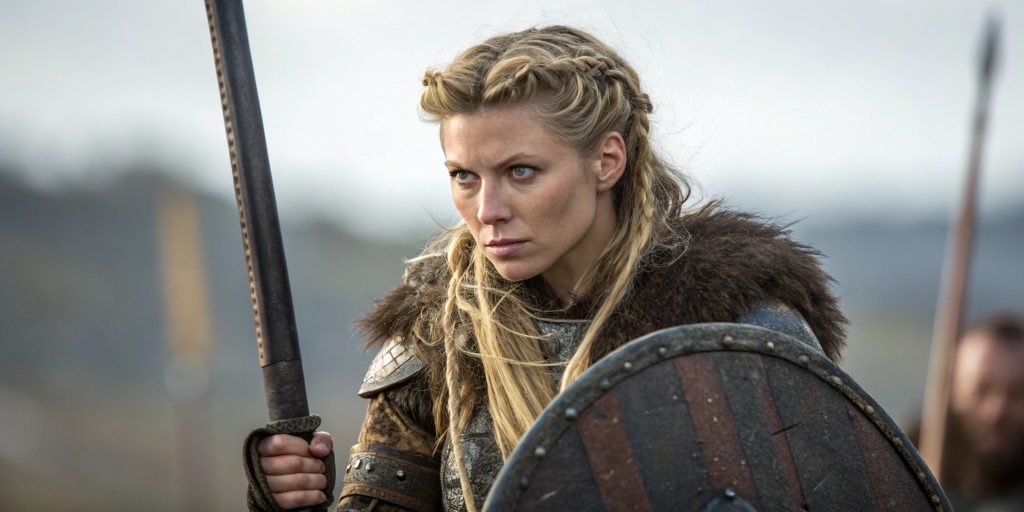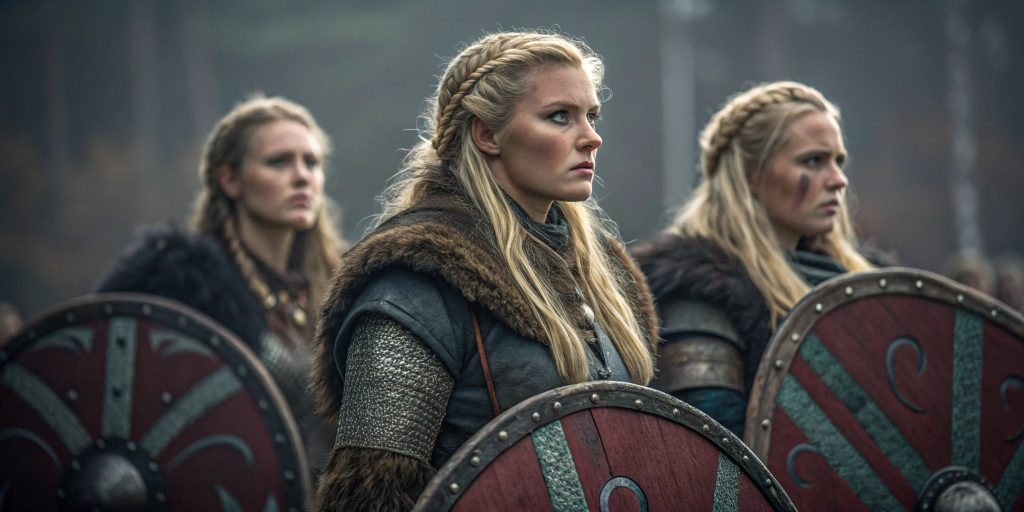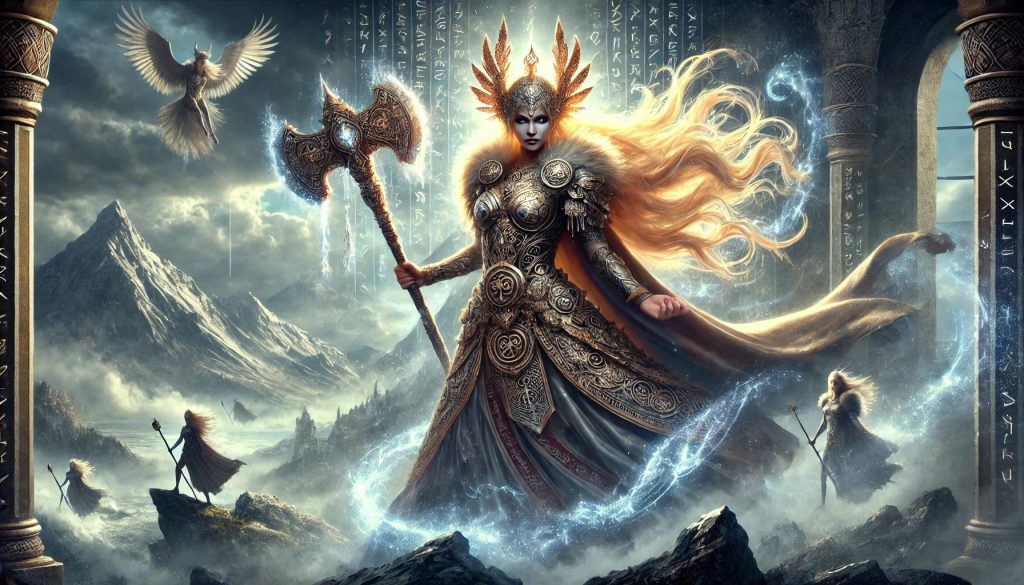Viking Raids and Warfare, Vikings
Did Female Vikings Fight?
Did female Vikings fight in battles? This question sparks a lively debate about women’s roles in Viking society. Legends often show a world of male warriors. However, evidence shows that female Viking warriors might not be myths.
Women played key roles in Viking communities. They were more than just wives and mothers. Archaeological finds, historical texts, and cultural norms can reveal the truth about female Viking warriors.
The Role of Women in Viking Society
Women in the Viking Age played many important roles. They were key to family, economy, and community life. They did more than just household chores; they managed homes and worked in the economy.
Women made textiles, such as clothes and home goods, showing their skills and value to the family. They also had legal rights, like owning property and starting a divorce, which gave them freedom not seen in many places back then.
This mix of roles and rights makes us wonder about women’s roles in wars and contributions to the Viking world. Women were important at home and in Viking society, including battles. As we learn more about Viking history, we see how vital women were during that time.
Exploring the Concept of Viking Warrior Women
Viking warriors, often seen as fierce men in armor with swords and axes, were part of a culture that included Viking women warriors. But Norse myths and sagas tell of strong female warriors, too. These women, called shieldmaidens, showed that fighting wasn’t just for men but also Viking women warriors.
In ancient Norse lands, female warriors were key figures fighting alongside men. Sagas showed their bravery and loyalty as they defended their families and communities. Their stories celebrated their skills and courage, making them respected battle friends and fierce warriors.
- Shieldmaidens were often depicted as valiant fighters, embodying the spirit of fierce warriors in the Viking world.
- They challenged societal expectations of women’s roles in Viking Age Scandinavia, proving that women could be fierce warriors.
- These narratives contributed to the broader understanding of female warriors in Viking culture.
The stories of female warriors in Viking lore are fascinating. They show the depth of gender roles and women’s abilities in ancient Nordic societies. Over time, these warrior women have become more important, sparking ongoing interest in their lives and impact.
Did Viking Women Fight? Understanding the Evidence
Viking women’s roles, especially as warriors, have long been a topic of interest. Archaeological finds and saga references tell the story of female Viking fighters. We explore the physical evidence from graves and the stories in historical accounts.
Archaeological Discoveries of Female Warriors
Archaeology has changed how we see Viking women. Graves have shown weapons, armor, and battle gear with female remains, fascinating archaeologists. This suggests women might have fought in wars or had important military roles.
The discovery of these items in female graves makes us consider Viking Age gender and combat norms.
Viking Sagas and Historical Accounts
The sagas are full of stories about strong female characters. Saxo Grammaticus wrote about women who fought bravely, sometimes with men. These stories entertain but also show the complexity of gender roles back then.
They give us insight into a time when women could be involved in war and conflict.
Famous Female Vikings and Their Legends
The Viking Age was filled with stories of brave women. Lagertha, a legendary shieldmaiden, is one of the most famous. Her story shows the strength and roles of women in Viking culture.

Lagertha, the Shieldmaiden
In Viking lore, Lagertha was a true warrior woman. She was fearless and skilled in combat, fighting alongside men and earning their respect.
Her legend is linked to Ragnar Lothbrok. It shows how shieldmaidens helped Viking warriors. Lagertha’s bravery inspired many, showing female power in Viking times.
Historical Figures in Viking Lore
Many women in Viking lore were important figures. They came from noble families and had a lot of influence. Women like Gudrid Thorbjarnardóttir and Freydis Eiríksdóttir were adventurous.
They traveled far and did daring things. Their stories show their bravery and their role in Viking history and culture.
Archaeological Finds: Women Buried with Weapons
Viking burial sites have shown us how vital women were in their society. Many graves have weapons, suggesting that women might have been warriors. This changes how we see Viking culture and gender roles.
Sites like Birka in Sweden have given clues about how women warriors were honored. Graves with weapons and other items show women’s importance. These finds highlight their status and roles in battles.
This evidence helps us see Viking society in a new light. It shows that women were not just passive figures; they could be part of the warrior traditions.
Gender Roles in Viking Age Scandinavia
Gender roles in Viking Age Scandinavia shaped daily life. Women and men had specific jobs and expectations. This affected how society was organized and what people could do.
Men usually hunted, fought, and traded. They were seen as protectors and providers, needing strength. Conversely, women cared for homes, raised kids, and kept communities in order. These jobs were vital for Viking society’s survival.
- Women’s tasks included making clothes, cooking, and looking after children.
- Class and status influenced how much work both genders did.
- Some high-status women had more power and made political decisions or led events.
While roles were important in Scandinavian society, they weren’t strict. In times of war, people beyond traditional roles fought. Women sometimes joined battles, showing that gender wasn’t just about fighting.
Exploring these roles shows that Viking-age Scandinavia was complex. It was more than just men and women doing different jobs. This complexity helps us understand the rich experiences of both genders at that time, reflecting the diverse roles within Scandinavian history.
Evidence of Female Warriors on the Battlefield
Viking women did more than just stay at home. They fought alongside men, showing great strength and toughness. Archaeology and stories tell us about their bravery and skills in battle.
Physical Strength and Training of Viking Women
Viking women were strong and fit, not just for household chores. They learned survival and fitness skills. This training might have helped them sail into battles on Viking ships.
Women Participating in Raids and Battles
Stories from history show Viking women warriors in battles and raids. The Battle of Brávellir is a famous example. It proves women were active and vital in Viking wars.
The Viking Warrior Culture
The Viking warrior woman culture is known for its deep traditions and strong values. Bravery, honor, and loyalty were vital. These values shaped the lives of warriors, both men and women and influenced the leadership of chieftains.
These values shone in training and battles. They gave warriors a clear purpose. The culture valued strength and skill, breaking down old gender roles.
Norse culture shaped the warriors’ traits. Heroic stories were a big part of viking life. They showed both male and female strength.
Women warriors were not common, but they were there. They showed that strength wasn’t just for men.
- Bravery as a core value
- Traditions surrounding warfare and honor
- Social structures supporting both male and female fighters
- Importance of skill and strength across genders
This mix of values made the Viking warrior woman culture special, contributing to Scandinavian history. It allowed women to fight like men, adding to the Norse’s fierce image. It told a story of warriors that included everyone.
Perceptions of Viking Women in Modern Context

Today, people often view Viking women with a mix of fascination and confusion. Movies and TV shows usually depict them as warriors and leaders, and they frequently depict famous Viking women in heroic roles, which makes us think they are strong and independent.
But, the truth is more complex. History and archaeology show that women did many things. They worked on farms, traded goods, and took care of families. These roles were important but often ignored.
It is key to examine how we see Viking women today. TV shows and books make women seem as powerful as men, which can lead us to misunderstand their actual roles in Viking society.
As we discuss gender more, we need to see Viking women in a new light. Studying their lives reveals their true roles, which helps us better understand their historical place.
Traditional Gender Roles vs. Fighting Women
Norse society had strict gender roles, but women warriors challenged these norms. Archaeology and history show women fought alongside men. This defied the usual expectations of women’s roles.
People often thought women only did household chores. They believed women couldn’t fight or go to war. But the truth is different:
- Warrior graves with women’s weapons.
- Sagas with women and men fighting together depict the valor of both genders in Old Norse culture.
- Stories of Viking women warriors in raids and battles highlight how women could take on fierce roles.
These discoveries show that women could be more than just caretakers. They were skilled warriors who broke gender norms, changing how we see women’s roles in Viking history.
Summary
Exploring if Viking women fought shows a rich history. Archaeology, sagas, and texts tell us they were involved in battles. They played big roles in warfare and in defending their communities.
The impact of female warriors goes beyond just fighting. They challenged old ideas about gender roles in the Viking world, showing that Viking society was complex, with women having power at home and in war.
The story of Viking women in battles is still growing. By seeing their bravery, we can learn more about the world. This makes history richer and sparks talks about gender today.

